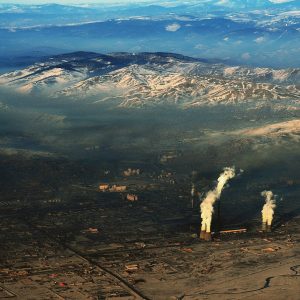As the crisp winter air flows across Inner Asia each year, a simmering threat resurfaces in Mongolia’s capital city of Ulaanbaatar.
Ulaanbaatar is home to 1.5 million people, half of Mongolia’s population. Despite its relatively small population, the city consistently ranks among the world’s most polluted cities. This year is no exception. On December 1, Ulaanbaatar’s Air Quality Index was 169, showing “unhealthy” air pollution levels with a particulate matter (PM) 2.5 concentration 18 times the World Health Organization (WHO) recommended level. It has remained well into unhealthy levels through December 7.
Ulaanbaatar is the coldest capital city in the world. Temperatures regularly fall well below -20 degrees Celsius. As a result, most of the population living in gers, traditional Mongolian yurts belonging mostly to migrants from the countryside, burn raw coal for heat as they do not have access to the central electricity grid of the capital. This practice has been identified as the main cause of Ulaanbaatar’s air pollution.
The city’s topography doesn’t help either. Ulaanbaatar is located in the narrow valley of the Bogd mountain on the Tuul river. This geography creates a thermal inversion layer above the city, which traps its toxic air.
This recurring phenomenon of toxic winter air in Ulaanbaatar can be best understood as a form of “slow violence.” This term was coined by literary scholar Rob Nixon in 2011 to describe the non-spectacular, sometimes even invisible, ways in which the most marginalized communities are being threatened by environmental degradation and anthropogenic climate change. Slow violence challenges the mainstream understanding of violence as immediate, explosive, or spectacular and, instead, sees violence as happening when people are denied basic needs through social, economic, and/or political structures such as institutionalized forms of racism, sexism, and classism.
The invisibility of toxic air pollution and its gradual accumulation over time makes it an excellent candidate for the “slow violence” analysis. In fewer places is this issue more pertinent than in Ulaanbaatar.
Understanding toxicity as a form of slow violence reveals some of the challenges involved in measuring and addressing air pollution. Air pollution is most commonly measured in terms of the amount of inhalable particulate matter in the atmosphere, especially the concentrations of PM2.5 and PM10. These scientific definitions of toxicity are derived from measurements made by satellite technology or remote sensing. While these methods can be very useful, they ignore the embodied experiences and health implications of this slow violence on a daily basis – factors that the idea of slow violence attempts to emphasize.
The toxicity of Ulaanbaatar’s winter air has very serious health implications for its population, particularly for children. Pneumonia is the second leading cause of death for children under 5, and children in Ulaanbaatar have 40 percent lower lung functioning capacity than children in rural areas of the country. Air pollution has also been strongly correlated with a decrease in delivered-infant conception rates during the winter months, demonstrating overall negative effects on reproductive health.
In order to address these health concerns, the government of Mongolia has shown sustained efforts to reduce air pollution in the capital, but the impacts are debatable. In May 2019, for the first time in history, the government implemented a ban on raw coal use. Instead, the government provided a form of processed coal product called briquettes, which burn for longer and don’t release fumes.
Despite initial hopes that this policy would be the silver bullet to solving air pollution in Mongolia, the long-term benefits of this policy have been widely contested. With the outbreak of the COVID-19 pandemic and the subsequent economic shutdown, lower-income households resorted to burning various forms of cheap dirty fuel, which significantly contributed to Ulaanbaatar’s horrific 2020 air quality, once again ranked the worst in the world.
With colder weather conditions expected in January and February, PM2.5 concentrations in the Mongolian capital could be up to 40 times higher than the WHO standard. There is no doubt that reducing the city’s raw coal consumption is a necessary step forward for improving air quality in Ulaanbaatar. Nevertheless, the slow violence analysis points out that toxic harm arises from systems of inequality and, unfortunately, also has disproportionate effects on the more at-risk members of the population.
Reducing poverty rates in the city and facilitating the integration of marginalized ger households into the city’s central energy infrastructure would be the real milestone for achieving healthier levels of air quality in Ulaanbaatar.

































